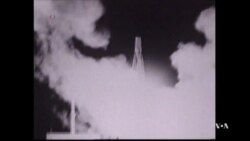Forty-five years ago, two U.S. astronauts became the first humans to step on the moon, the remarkable culmination of a fierce competition in space technology between the U.S. and the former Soviet Union.
Beginning in the U.S.-Soviet Cold War of the 1950s, the space race was as much about politics as science, says former Russian cosmonaut and deputy director of the Memorial Museum of Cosmonauts, Alexander Laveykin.
“There was a big competition between us and America: who will launch the first space satellite? It turned out, we were the first ones," said Laveykin.
That succesful launch of man-made satellite, Sputnik 1 — a 58 centimeter metal ball with four antennae that circled the globe and transmitted a simple signal — was a bitter pill for the American public to swallow.
Less than five months later, in January 1958, the U.S. launched its first satellite, Explorer 1, which discovered the Van Allen radiation belt.
But the Soviets pulled ahead again in April 1961, when the first cosmonaut Yuri Gagarin took a single swing around the planet, and succesfully returned to a hero’s welcome.
One month later, the first American astronaut Alan Shepherd reached suborbital altitude and parachuted back to earth.
“On the periscope, what a beautiful view," said Shepherd from far above the earth. "Cloud cover over Florida, three to four tenths up the eastern coast, obscures up through Hatteras.... I'm getting ready for impact."
Growing public and political pressure prompted then-President John Kennedy to set America's sights higher: to land on the moon, says National Air and Space Museum curator Kathleen Lewis.
“On the United States side, I think there is a bit of hubris that we can do anything better," said Lewis.
Before the decade was over, on July 20, 1969, American Neil Armstrong became the first human being to walk on the moon.
In the years that followed, the space race slowed and moved toward cooperation when in 1975 Washington and Moscow conducted the first manned rendezvous in space.
In time, the rivalry would fizzle, due to the task of building the International Space Station, the demise of Communism, and NASA’s decision to retire its shuttle fleet.
According to Kathleen Lewis of National Air and Space Museum, the current earth-bound, geopolitical rivalry between the U.S. and Russia does not seem to adversely impact bilateral cooperation in space.
“You don't want to be arguing politics when you're up in a tin can 200-and-some miles [325 km] above Earth," she said. "You have nowhere to go, so you've got to focus on things that you can agree on and avoid the things that you might have disagreements on."
At the moment, the two space agencies do not have plans for greater cooperation, but their competitive space race is definitely a thing of the past.











